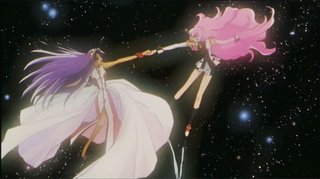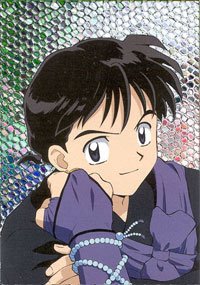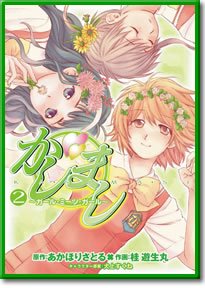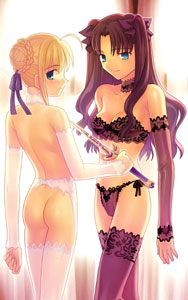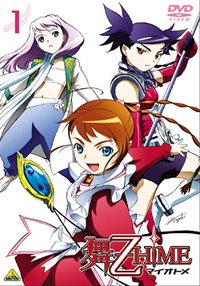Mai Otome 20

So, I finally get around to talking about the series proper. Lots of stuff has transpired since my last post on this topic. We got a new OP, some death, some revelations, lots of melodrama, lots of angst, and lots of questionable writing. All of which I'll try to touch on here with the help (or not) of some screen caps. Check here and here for better screencaps and summaries.
Heroic Trio:Well, let's start with this first. We finally learn more of Nina's background and the presence of a capsule in Nina's flashback hints that she was present at Windbloom 15 years ago. Though it's still unclear at this point whose baby she might have been.
In Ep. 1 we saw Rena setting a baby adrift in a similar capsule, only that baby had the Souten no Seigyouku. Which, barring some ridiculous plot complication (considering the source, not entirely unlikely), we can conclude was Arika. The old retainer's flashback in 14 reveals that there were at least two babies and she suggests that the baby with the Souten no Seigyouku was the true royal heir. If, Rena was trying to protect the baby Princess then multiple capsules would be a good decoy, though as I argued in my last post, Rena's protection of any capsule marked it as important, so it wouldn't necessarily make sense for Rena to be carrying the real princess.
However, Rad's admission in 19 that Aswad's presence at Windbloom was to neutralize Rena, then it wouldn't matter so much if she was protecting the princess, since Aswad was only interested in Rena. Schwarz, on the other hand may have been interested in the babies and their connection to the Harmonium, though more likely, the Minister of the Interior who had ambitions of power probably wanted the Princess dead to insure his bloodline would rule Windbloom. In this case, Aswad was probably the best enemy Rena could have ran into.
So, let's say we saw Rena sending off "the Princess" in Ep. 1, then the capsule in 20 may be the one carrying "Rena's daughter." Though that still leaves the question of whose child Mashiro is. While Rad's admission also makes the case for Mashiro not being the Princess nor Rena's daughter stronger, I don't think the identity of the real princess is important to the future of Windbloom, as Mashiro will still be Queen at the end of the series, rather the true identities of the babies are important to operation of the Harmonium. This is supported by the closing scene of 20 when Nina steps up to the Harmonium and it opens for her.
Why are the babies identities important? I suspect bloodlines, specifically the bloodlines of Fumi and her master, since they were the ones who activated the Harmonium the first time. From 20 we learn that Fumi's power as shinso derives from the fact that she gave birth, and that Schwarz used the body of Rena, who had also given birth, in the same capacity to neutralize Fumi and create their own Otomes called Valkyries. So, I imagine that Fumi's and her master's descendants would have to play a role in the second use of the Harmonium, and frankly given that it is Mashiro, and considering their roles in Mai HiME, I can't imagine Mashiro has absolutely no connection here, perhaps she is Fumi's descendant. But then that raises all sorts of other questions and I shudder at the contortions the plot might take to answer them.
Suffice to say that Mashiro, Arika and Nina are key in the use of the Harmonium, regardless of how they qualify or why.
Big Picture: Couple of things under this heading. I postulated in my prior posts that the Otome system and Garderobe are inherently oppressive, and the international tensions and decline of civilization on Earl are the result of this oppression. While I don't think it's entirely incorrect in light of the last couple of episodes, I was clearly thinking along different lines than SUNRISE, in terms of economic and political fallout from the introduction of Otomes and Garderobe. The difference mainly being that I actually considered political and economic fallout.
The point that John Smith, Erstin, Midori and Nagi make, that Garderobe shouldn't have a monopoly on technology is totally spot on, IMHO, and I'm pretty sure that monopoly will be removed before the end of the series. Though it will be co-opted by Mashiro and Arika and be made part of their victory over the "bad guys". Which is annoying, as I've yet to hear a coherent counter argument as to why the suppression of technology and knowledge is a good thing or should be continued. All we have is that the "bad guys" say it so it must be no good.
I had thought in the beginning of the show that we might get to see some interational intrigue, especially as they went out of their way to make Argoss look the part and they make clear references to current nations. But similar to GSD, nation state politics seem to be incidental to the plot, as Yukino exemplifies in this episode. They are little more than chess pieces, unfortunately.
Argoss does assess the situation accurately but acts unilaterally to attempt to secure Kardea/Carlteya, not an unreasonable action, but it's executed in a clearly negative way. Midori and Aswad, after getting used and abused this series will probably get their victory there.
Yukino and Airies/Ealis, however, gets the seemingly responsible part of waiting until they're sure, but really is just another sacrifice to plot necessity. How else to explain how two first hand accounts (Nao, Natsuki) and inside information (Chie) aren't enough to get involvement from an allied country. If Argoss was suspicious of Nagi, I'm sure other countries are as well, and how hard would it be to persuade them with that information to at least put some pressure on Artai? No, Natsuki gets no help, because it's not convenient to the plot to do so yet. Just like it wasn't convenient to the plot to go after the Schwarz cannon in 17 when it was clearly the most logical thing to do.
Characters: Mashiro's development of the main three has been the most straight forward and is the better of the three. You see how much she's grown especially in the last couple of episodes, hopefully they'll keep her development as straight forward as possible.
Arika's development seems to be more complex and deeper, but I think it's actually a zero sum equation. Looking back over the series every complication, when it's resolved, only seems to bring her back to herself, rather than make her stronger or wiser.
Nina's development has been the most lacking to date, aside from learning to open up and enjoy her friends, she's still the essentially the same overly insecure girl with the Elektra complex she was at the beginning, though I suspect that the keys to her growth are plot complications to be revealed in the last 6 episodes.
Sergey, aside from being the Lu Buwei to Nagi's Qin Shi Huang, has become a somewhat active participant in a really uncompelling love polygon. Being a Dirty Old Man I don't have (much of) a problem with it on face, I'm just not interested in who wins the Sergey sweepstakes. If Nina were actually related to Sergey by blood, then it might be more interesting, but only in a Jerry Springer sort of way.
Nagi is probably more devious and manipulative in MO than he was in MH, but honestly he's like the cliched one eyed man. And for that we the have writers to blame.
Nao has been one of the few brights spots in terms of characters, her characterization is good to the point where you want to see more of her, but more Nao means greater chance that they'll ruin her character somehow.
Miyu = Deus ex Machina in waiting.
Midori and Aswad: I prefer Midori "FOR GREAT JUSTICE!!!" to Midori Hardened and Ruthless Rebel Leader, but Aswad has dropped from being a player to a pawn in the last couple of episodes, and that's a shame.
I'm holding out hope that Aoi shows up again to a happy reunion with Mashiro and Chie. Speaking of Chie hopefully she'll survive her spying to reach a potential reunion with Aoi.
Haruka and Yukino still make a great comedy team, but I wish they'd balance Haruka out with some ass-kickery.
And then there's Mai, it's getting pretty late in the series and she still hasn't shown up yet, which makes me wonder if she actually will. I was thinking that Mai's return would herald a liberation of the Otome from their limits, but who knows. If anything I imagine she's the cliffhanger ending of 24. But, I won't be surprised if all we get is her appearance in the opening and a brief cameo in 26.
Shizuru/Natsuki/Tomoe: This is a polygon I can get behind, especially if it cements ShizNat as canon. That will more than make up for the sacrificing of their characters on the altar of plot necessity or comic relief.
Let's start with Tomoe and how she compares to MH Shizuru. I said this before to Zyl so I'll quote it here:
The difference between Shizuru Fujino and Tomoe is that while we knew Fujino liked Natsuki, her desires didn’t become creepy/obsessive until after the HiME festival started, which was pretty late in the series, and after we got to know her character. Which is why so many people were distressed by Shizuru’s descent into the clichéd psycho-lesbian role. Tomoe was giving off creepy, stalking vibes early on (Episode 2 or 3 maybe). So for me, what was grafted onto Shizuru Fujino in HiME defines Tomoe in Otome.Tomoe was supposed to be the psycho lesbian from the beginning, but she's more run of the mill sociopathic than over the top psycho. (Though Shiho may qualify for the latter in this series.) And releasing Shizuru from her cell will ultimately lead to her downfall, because Shizuru is smarter than Tomoe. Really the whole scene was study in manipulation by letting the Tomoe think she was in control. Any advantage Tomoe might have had was conceded in the face of this look.
Shizuru lets Tomoe have her bit of fun, because any resistance or rejection would probably put her back in the cell. She has a much better shot of either escape or subterfuge from within Tomoe's room than in that cell. And judging by that last shot of her looking away as Tomoe fulfilled her fantasies, she was already thinking of ways to use Tomoe's obsession against her, that or she's desperately trying not to retch. After seeing this and this in the preview, I almost feel sorry for Tomoe, because Shizuru is going to break her.
The shot of Natsuki sensing a disturbance in the Force, is another in a long line of vicious teasing by SUNRISE on our favorite couple. Though again it's another very strong hint in favor of, otherwise, why cut to Natsuki at all during that?
Other observations: Animation quality fluctuated pretty badly this episode. For this shot Jessica Rabbit's "I'm not bad, I'm just drawn that way." is very appropriate.
I'd really like someone to try and explain the biology of lava as a digestive fluid, or why the inside of a Jabar looks like a cave formation, even though I know it's excersize in futility.
This shot of Tomoe and friends in what Erica calls the "SS Maid" uniform needed more slo-mo.
More next week, in the meantime, join Zyl and I as we take solace in Urayo's hilarious fan art.
